
by Liam Hunt | Jul 12, 2023 | Inflation, Monthly CPI Updates
The Consumer Price Index for All Urban Consumers (CPI-U) increased by 0.2% on a seasonally unadjusted basis in June 2023, according to the Bureau of Labor Statistics report published July 12. Year-over-year, before seasonal adjustment the all-items index grew by 3.0%, constituting a major deceleration in the CPI-U from May’s 4.0% reading.
June’s rosy CPI report is the lowest in two years, when March 2021’s CPI report came in at 2.6% year-over-year. This month’s CPI report fared better than economists and investors expected, causing an immediate surge in the benchmark stock market indices on the morning of July 12. The rapid deceleration of the inflation rate in the U.S. is being taken by many as evidence that the Federal Reserve’s hawkish interest rate policy is performing as intended by successfully reining in inflation.
Nonetheless, the June 2023 CPI numbers are still 50% higher than the Fed’s target inflation rate of 2%—a figure that some doubt is possible to achieve without future rate hikes from the central bank.
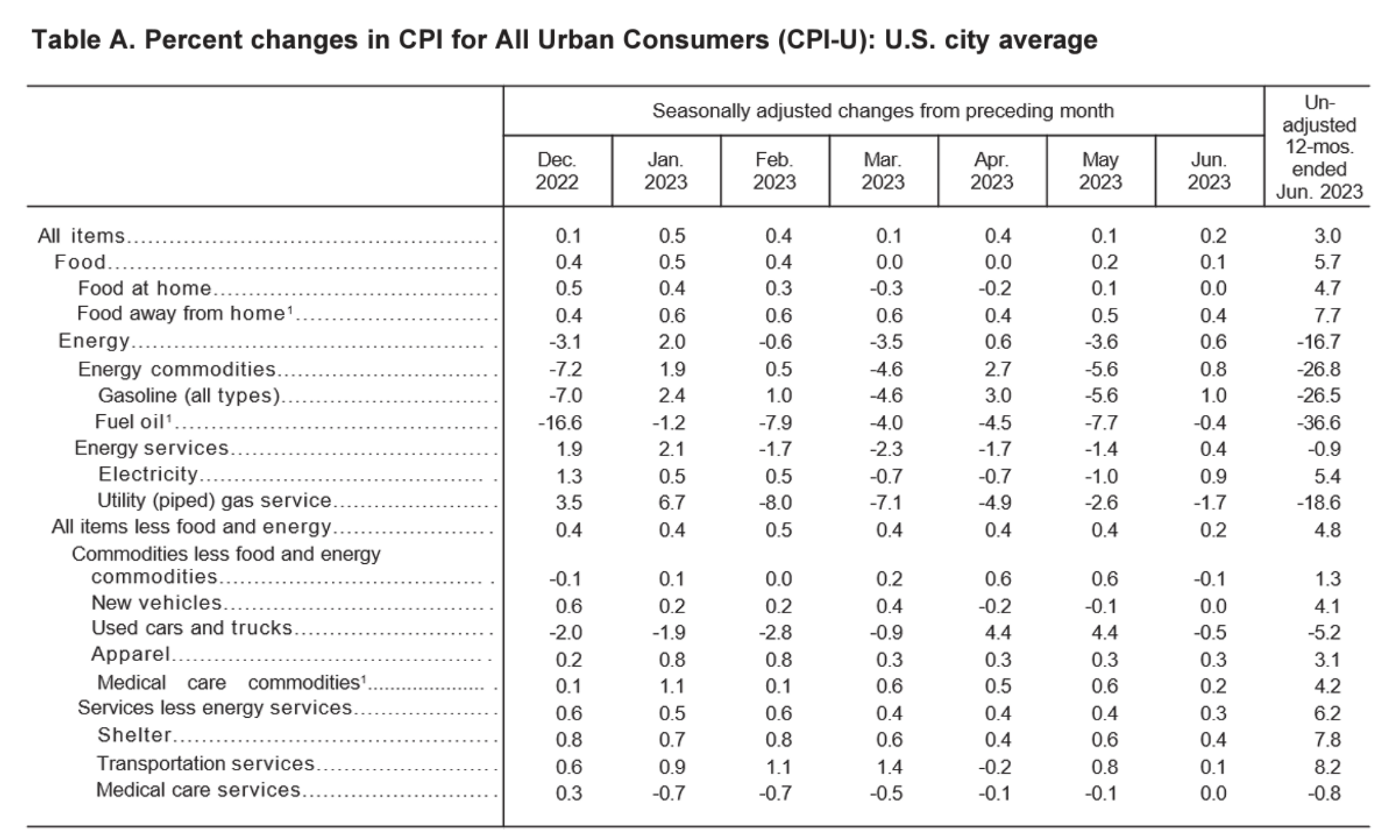
Source: Bureau of Labor Statistics
June’s monthly CPI figure (0.2) came in higher than the previous month’s (0.1). The previous month’s “blip” in the monthly CPI report can be largely explained by the base-year effect seen between April 2021 and 2022 due to the Russian invasion of Ukraine, an event that saw immediate and large-scale price increases in oil, gas, and certain natural resources. These prices then partially settled in the subsequent months.
As depicted in the table above, the June 2023 CPI figure was largely driven by increases in consumer energy commodities and overall energy price increases.
Food Prices
The food index rose 0.1 percent in June after going unchanged in April and increasing 0.1 percent in May, representing a core market segment where consumer prices stagnated compared to the month prior. Notably, egg prices fell 7.3 percent in June after falling significantly in May—in total, egg prices have fallen by nearly half since the start of the year following a devastating avian flu outbreak that killed 43 million hens in 2022.
The meats, poultry, and eggs index dropped by 0.4 percent in June on the heels of an even large 1.2 percent decrease in May(-1.2%). However, year-over-year, the food at home index has risen by 4.7 percent, meaning your total grocery bill today compared to June 2022 is nearly 5 percent higher on average.
Energy Prices
The energy index rose in June May (0.6%) after falling in May. Notably, gasoline prices increased by 1.0 percent after dropping 5.6 percent in May. Concurrently, natural gas fell by 1.7 percent in June, marking the third consecutive month of natural gas price cuts. Fuel oil prices also fell, by about 0.4 percent in June.
Overall, energy costs inched up in June, constituting a minor deviation in the general trendline of falling energy prices ongoing since March. Year-over-year, energy prices are up 16.7 percent over 12 months.
Core June 2023 CPI
Regarding the core CPI data for June 2023 (inflation less food and energy), the index rose 0.2% month-over-month in June, down from a 0.6 percent acceleration in May. Below is an itemized breakdown of the main price fluctuations seen within June’s core CPI reading:
- Shelter index: +0.4% (+0.6% in May)
- Used cars and trucks: +4.4 (+4.4% in May)
- Lodging away from home: (-2.0%) (+1.8% in May)
- Medical care index: +0.1% (unchanged from May)
- Household furnishings: +3.6%
- Airline fares: (-8.1%) (-3.0% in May)
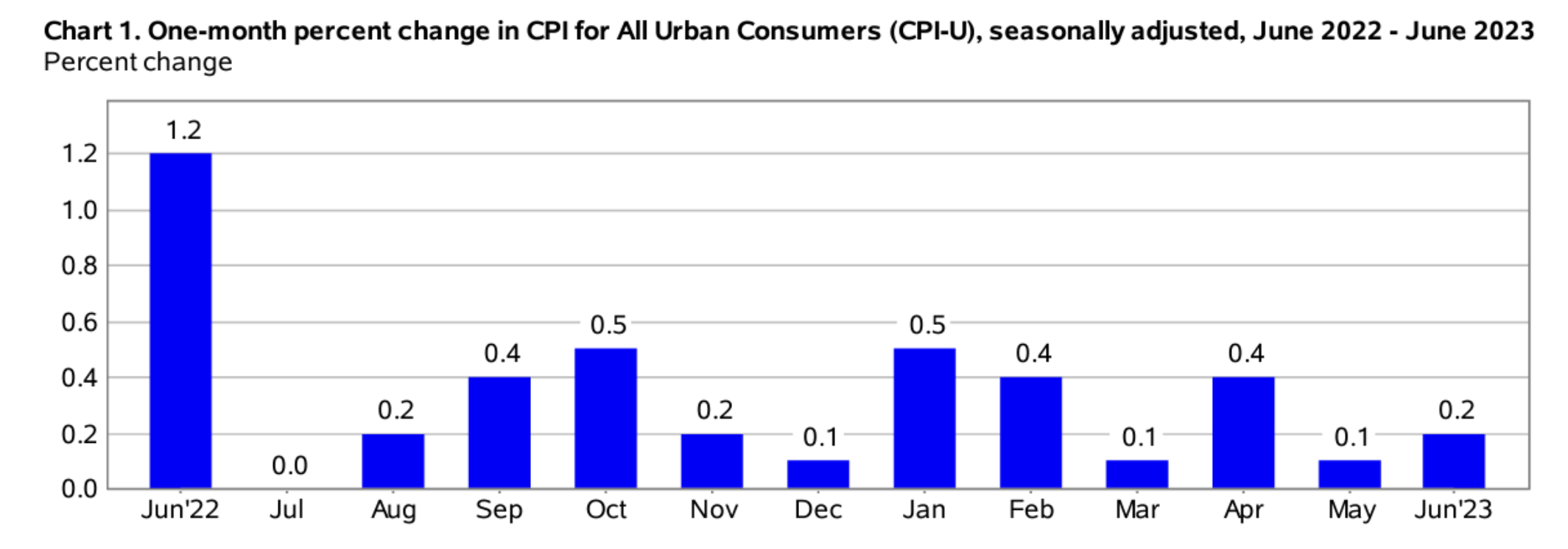
Source: Bureau of Labor Statistics
Seasonally Unadjusted CPI Data for June 2023
Before seasonal adjustments, the CPI-U for June 2023 increased (+0.3%) for the month, rising to an index level of 305.109. Since these figures are unadjusted, they include regular seasonal price fluctuations that generally occur by the same margins every year.
Now Is The Time to Protect Your Wealth
Although June’s CPI report may seem rosy, the U.S. dollar is only continuing to lose value by the day. The result? Millions of American families with less purchasing power than they had the month prior, making it that much harder to make ends meet. While inflation is beginning to enter familiar territory, the average American household has lost the equivalent of $7,400 in annual wages due to inflation and rate hikes since 2021.
Luckily, we can mitigate the adverse effects of inflation. Consider speaking to your financial advisor about diversifying your investment portfolio with alternative assets that may help insulate your savings from the devaluation of the U.S. dollar.
Gold and silver have historically outperformed traditional securities during most recessions and economic crises, including the 2020 stock market crash and the 2008 global financial crisis. For many, gold functions as an inflation hedge, providing a much-needed store of value when fiat assets depreciate. No wonder why it’s sought after by many successful investors like Ray Dalio and Kevin O’Leary as a risk management tool.
Want to get started investing in silver or gold? Open an account today with one of the best-rated gold IRA service providers. While you’re at it, stay up-to-date on inflation news in the months ahead. You can easily keep tabs on how inflation is holding back your household’s purchasing power by using our free CPI inflation calculator tool that tracks the wealth-eroding effects of inflation.

by Amine Rahal | Jun 30, 2023 | Definitions, Inflation
In the realm of economics, three terms often crop up in discussions about the health of an economy: inflation, recession, and depression. While they are interconnected in various ways, each term represents a distinct economic phenomenon with different implications for the economy and, by extension, for investors, businesses, and consumers. This article will delve into the definitions of inflation, recession, and depression and explore how they are linked. Let’s start by looking at a comparison table:
|
Inflation |
Recession |
Depression |
| Definition |
General increase in prices. |
Significant decline in economic activity, typically for two quarters or more. |
Severe and prolonged downturn in economic activity. |
| Impact on Economy |
Decreases purchasing power. Can stimulate economic activity when moderate, but leads to instability when too high. |
Results in higher unemployment, decreased consumer spending, and economic slowdown. |
Severe declines in employment and production, often causing significant economic hardship. |
| Common Causes |
Excessive growth in the money supply, demand-pull, or cost-push factors. |
Various, including financial crises, economic bubbles, or external shocks. |
Often a severe or prolonged recession, but can also be caused by a financial crisis or large-scale economic dislocation. |
| Central Bank Response |
May raise interest rates to slow economic activity and curb inflation. |
May lower interest rates and increase government spending to stimulate economic activity. |
Similar to recession, but response typically needs to be larger and more sustained. May involve significant fiscal policy responses as well. |
| Link to Other Two Terms |
High inflation can lead to a recession. Recession can lead to low inflation or deflation. |
Can turn into depression if severe and prolonged. Lower demand during a recession can lead to lower inflation. |
Could lead to deflation due to lower demand. However, policy responses could potentially lead to inflation. |
Inflation
Inflation is the rate at which the general level of prices for goods and services is rising, eroding purchasing power. In other words, as inflation increases, each unit of currency buys fewer goods and services. Inflation is updated monthly.
Moderate inflation is typical in a growing economy and can even stimulate economic activity. However, if it gets out of hand, it can lead to economic instability. The BLS uses the CPI to measure inflation.
The Federal Reserve, like most central banks, aims to control inflation by adjusting interest rates. Lower interest rates encourage spending and investment, which can boost economic activity and, potentially, inflation. Higher interest rates can slow economic activity and curb inflation.
Recession
A recession is typically defined as a significant decline in economic activity spread across the economy, lasting more than a few months. This is often seen in real GDP, real income, employment, industrial production, and wholesale-retail sales. Economists generally agree that two consecutive quarters of negative GDP growth indicate a recession.
Recessions can be caused by various factors, including financial crises, external shocks, and the bursting of economic bubbles. Policymakers often respond to recessions by lowering interest rates and increasing government spending, aiming to stimulate economic activity.
Depression
A depression represents a severe and prolonged downturn in economic activity. It’s more extended and more profound than a recession, characterized by significant declines in output, employment, and trade, often lasting several years. The most notable example is the Great Depression of the 1930s.
Depressions are rare, and economists don’t have a standardized definition like they do for a recession. However, they generally agree that depressions involve a substantial contraction in economic activity that lasts several years.
How Are They Linked?
Inflation, recession, and depression are intertwined in many ways:
- Inflation and Recession: Too much inflation can lead to a recession. When prices rise too quickly (hyperinflation), consumers can struggle to afford goods and services, and businesses can find it challenging to plan for the future. If the central bank tries to combat high inflation by raising interest rates too quickly, it can cool the economy too much and lead to a recession.
- Recession and Inflation: On the flip side, recessions can lead to lower inflation or even deflation (a general decrease in prices). In a recession, demand for goods and services falls, which can lead to lower prices.
- Recession and Depression: If a recession is particularly severe and prolonged, it can turn into a depression. While there’s no strict dividing line, depressions involve higher unemployment, lower output, and more significant declines in standards of living than recessions.
- Inflation and Depression: Inflation rates during a depression can vary. Sometimes, depressions can involve deflation, as demand for goods and services falls and businesses lower prices to try to entice customers. However, economic policy responses to a depression could lead to inflation. For example, if the government responds by increasing the money supply or government spending dramatically, it could eventually lead to increased inflation.
In summary, inflation, recession, and depression are all interconnected elements of economic cycles. By understanding these terms and their relationships, we can better grasp the complexities of economic health and make
FAQ
Q1: What causes inflation? A1: Inflation can be caused by various factors, including excessive growth in the money supply, demand-pull inflation where demand for goods and services outpaces supply, or cost-push inflation where the cost of raw materials or wages increase.
Q2: How can inflation be controlled? A2: Central banks often aim to control inflation by adjusting interest rates. By raising interest rates, central banks can decrease borrowing and spending, thus reducing inflation. Conversely, lowering interest rates can stimulate borrowing and spending, potentially leading to increased inflation.
Q3: What are the signs of a coming recession? A3: Common signs of a coming recession include a decline in the GDP, higher unemployment rates, lower consumer spending, decrease in business profits, and a volatile stock market.
Q4: How can a recession affect the average person? A4: During a recession, people might face job loss or reduced working hours. They may also see the value of their investments decrease, and it could become harder to get credit.
Q5: What’s the difference between a recession and a depression? A5: The main difference between a recession and a depression is the duration and severity of the economic downturn. A recession is a temporary decline in economic activity, typically lasting six months to a year. A depression, on the other hand, is a severe and prolonged economic downturn, often lasting several years.
Q6: How do governments respond to a depression? A6: In a depression, governments may enact expansive fiscal policies, such as increasing government spending, cutting taxes, or both, to stimulate the economy. Central banks may also adopt expansionary monetary policies, such as lowering interest rates or implementing quantitative easing.
Q7: Can a depression lead to inflation? A7: A depression could potentially lead to deflation due to lower demand. However, the economic policy responses to a depression, such as increasing the money supply or government spending, could eventually lead to increased inflation.
Q8: How does a recession affect inflation? A8: A recession typically leads to lower inflation or even deflation. This is because, in a recession, the demand for goods and services falls, which can lead to lower prices. However, the specific impact on inflation can vary depending on the nature and severity of the recession, and the policy responses to it.
Q9: What role do central banks play in managing the economy through these cycles? A9: Central banks play a crucial role in managing the economy through inflation, recession, and depression. They often use tools like interest rates and open market operations to influence the money supply, aiming to stabilize prices and maintain low unemployment rates.
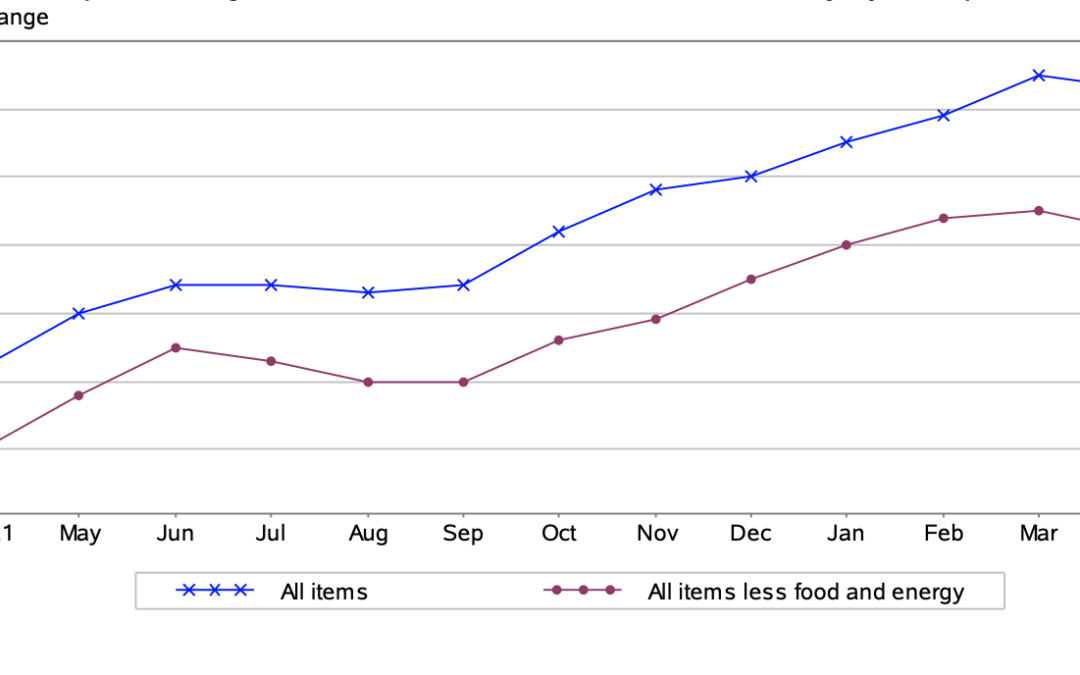
by Sarah Bauder | May 11, 2022 | CPI, Inflation
The Consumer Price Index for All Urban Consumers (CPI-U) rose by 0.3% on a seasonally adjusted basis in April, reported the U.S. Bureau of Labor Statistics. Since this time last year, the all items index grew by 8.3% prior to seasonal adjustment.
“Increases in the indexes for shelter, food, airline fares, and new vehicles were the largest contributors to the seasonally adjusted all items increase. The food index rose 0.9 percent over the month as the food at home index rose 1.0 percent. The energy index declined in April after rising in recent months. The index for gasoline fell 6.1 percent over the month, offsetting increases in the indexes for natural gas and electricity.
The index for all items less food and energy rose 0.6 percent in April following a 0.3-percent advance in March. Along with indexes for shelter, airline fares, and new vehicles, the indexes for medical care, recreation, and household furnishings and operations all increased in April. The indexes for apparel, communication, and used cars and trucks all declined over the month.
The all items index increased 8.3 percent for the 12 months ending April, a smaller increase than the 8.5-percent figure for the period ending in March. The all items less food and energy index rose 6.2 percent over the last 12 months. The energy index rose 30.3 percent over the last year, and the food index increased 9.4 percent, the largest 12-month increase since the period ending April 1981,” stated the Bureau of Labor Statistics in its monthly report.

(Source: U.S. Bureau of Labor Statistics)
Food
The index for food rose by 0.9% in April, marking the seventh consecutive monthly rise in this index. The food at home index saw a 1% for the month, with five of the six grocery store food composite indexes all experiencing percentage increases.
The food at home index rose 10.8% over the last 12 months, the largest 12-month increase since the period ending November 1980. The index for meats, poultry, fish, and eggs increased 14.3% over the last year, the largest 12-month increase since the period ending May 1979. The other major grocery store food group indexes also rose over the past year, with increases ranging from 7.8% (fruits and vegetables) to 11% (other food at home).
The index for food away from home rose 7.2% over the last year. The index for full-service meals rose 8.7% over the last 12 months, the largest 12-month increase since the inception of the index in 1997. The index for limited-service meals rose 7% over the last year, while the index for food at employee sites and schools fell 30%, reflecting widespread free lunch programs,” explained the bureau.
Energy
The index for energy decreased 2.7% in April, after soaring 11% the previous month. Gasoline prices dropped 6.1% after leaping 18.3% in March. Composite energy indexes all saw percentage rises including the natural gas index by 3.1% and the electricity index by 0.7%.
“The energy index rose 30.3% over the past 12 months. All the major energy component indexes increased over the year. The gasoline index increased 43.6% and the fuel oil index rose 80.5%. The index for electricity rose 11%, and the index for natural gas increased 22.7% over the last 12 months,” explained the Bureau of Labor Statistics.
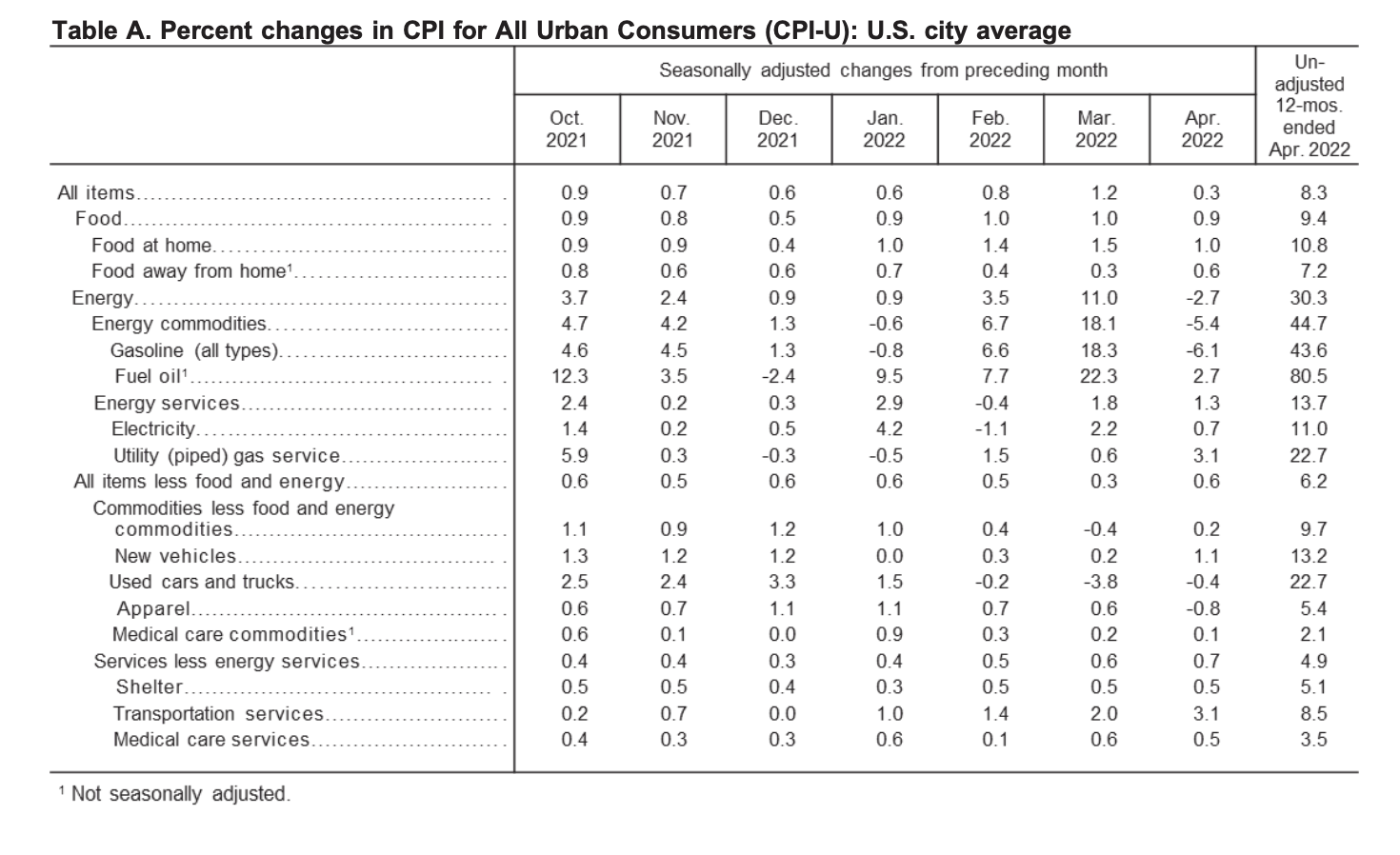
(Source: U.S. Bureau of Labor Statistics)
All Items Less Food and Energy
The all items less food and energy index grew 0.6% in April. The index for shelter rose 0.5%. The index for rent increased 0.6% and the owners’ equivalent rent index increased by 0.5%.
“The index for all items less food and energy rose 6.2 percent over the past 12 months. Virtually all major components have increased over the span. The shelter index rose 5.1 percent over the last year, and the medical care index increased 3.2 percent. Several transportation indexes show notable increases including used cars and trucks (+22.7 percent) and new vehicles (+13.2 percent). The index for airline fares rose 33.3 percent over the last year, the largest 12-month increase since the period ending December 1980,” stated the bureau in its report.
Source cited: https://www.bls.gov/news.release/archives/cpi_05112022.htm
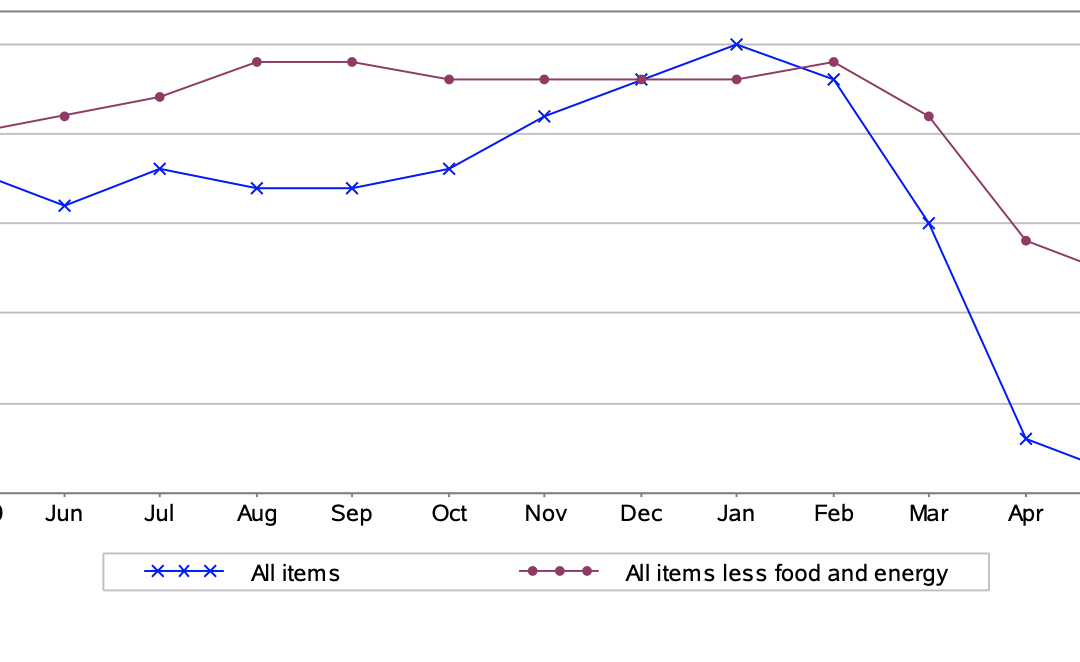
by Sarah Bauder | Jun 10, 2020 | CPI, Inflation
The Consumer Price Index for All Urban Consumers (CPI-U) dropped 0.1% in May, after plummeting 0.8% in April, reported the US Bureau of Labor Statistics. This percentage is on a seasonally adjusted basis.
The all items index has edged up 0.1% before seasonal adjustment, over the past year.

(Source: US Bureau of Labor Statistics)
Energy Index
The index for energy dropped 1.8% in May, after plunging 10.1% in April (which marked the steepest monthly decline for the index since November 2008). Gas prices dropped 3.5% in May, after plunging 20.6% in April. The index for electricity also decreased 0.8%, which was the largest one month drop since May 2015, stated the US Bureau of Labor Statistics. Conversely in May, the natural gas index increased by 0.8%.
Overall over the last 12-month period, the index for energy declined 18.9%, with all major energy indexes seeing significant decreases. Gas prices plunged33.8%, and the fuel oil index likewise plummeted 37.5%. In addition, the natural index fell 0.3%, and the electricity index dropped 0.2% over the past 12 months.
Food Index
In May, the food index rose by 0.7%. The increase was contributed to the 3.7% rise in the index for meats, poultry, fish, and eggs, stated the US Bureau of Labor Statistics. Additionally, the bureau reported that the beef index soared 10.8% in May, marking the largest monthly increase of the index since records have been kept.
Over the last 12 months, the food at home index has risen 4.8%. The index for meats, poultry, fish, and eggs rose 10% since this time last year. This marks the steepest 12-month rise in this index since May 2004, reported the bureau.
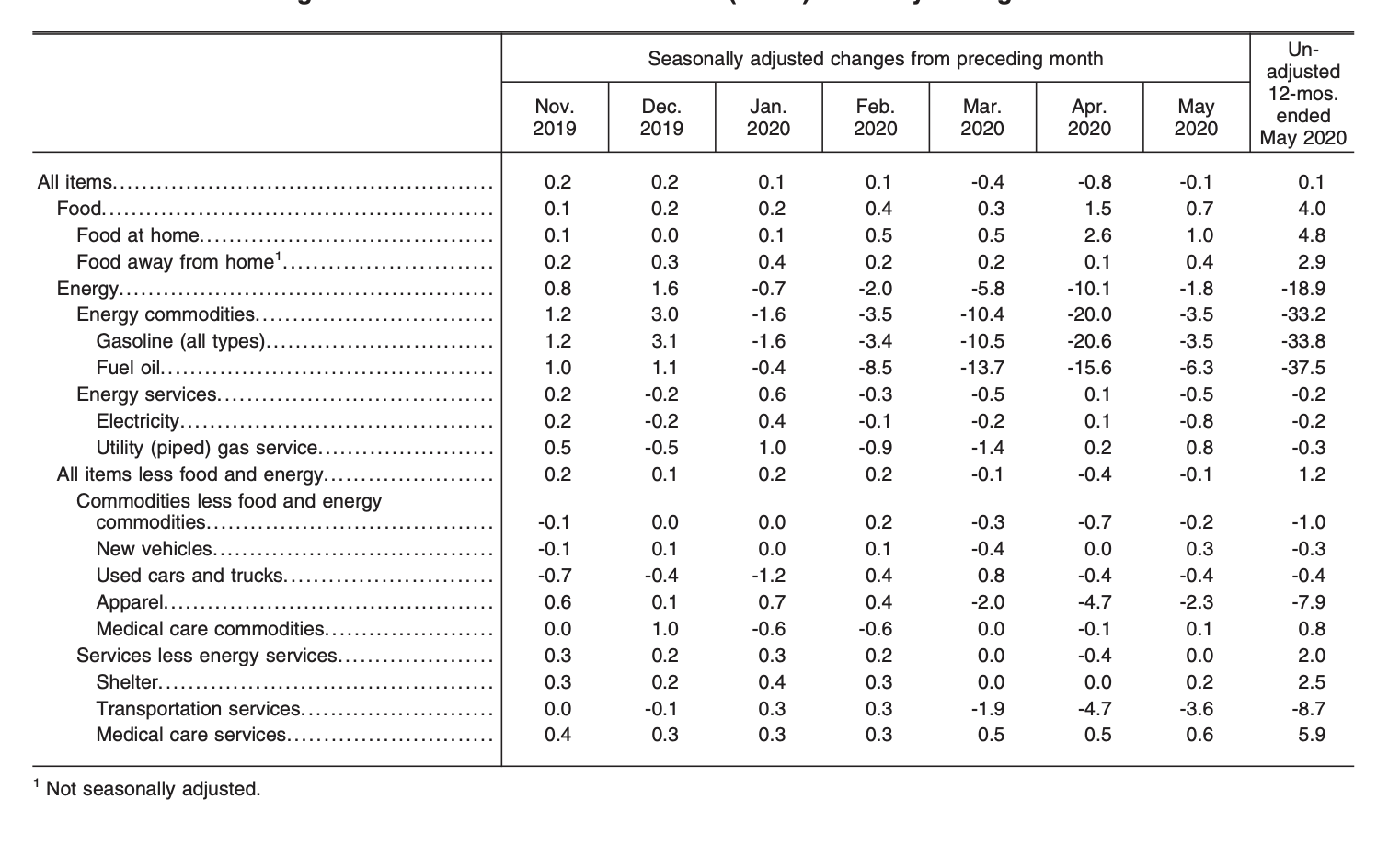
(Source: US Bureau of Labor Statistics)
All Items Less Food and Energy Index
In May, the all items less food and energy index dropped 0.1%. Component indexes all saw declined including motor vehicle insurance by 8.9%, the apparel index by 2.3%, and the airline fare index by 4.9%. Conversely, the shelter index increased by 0.2%, as did the medical care index by 0.5%.
Over the last 12-month period, the index for all items less food and energy increased by 1.2%. The index for shelter edged up 2.5%, as did the medical care index by 4.9%. Component indexes that saw major decreases were the airline fare index by 28.8% and motor vehicle insurance by 14.3%, reported the US Bureau of Labor Statistics.
Source cited: https://www.bls.gov/news.release/archives/cpi_06102020.htm
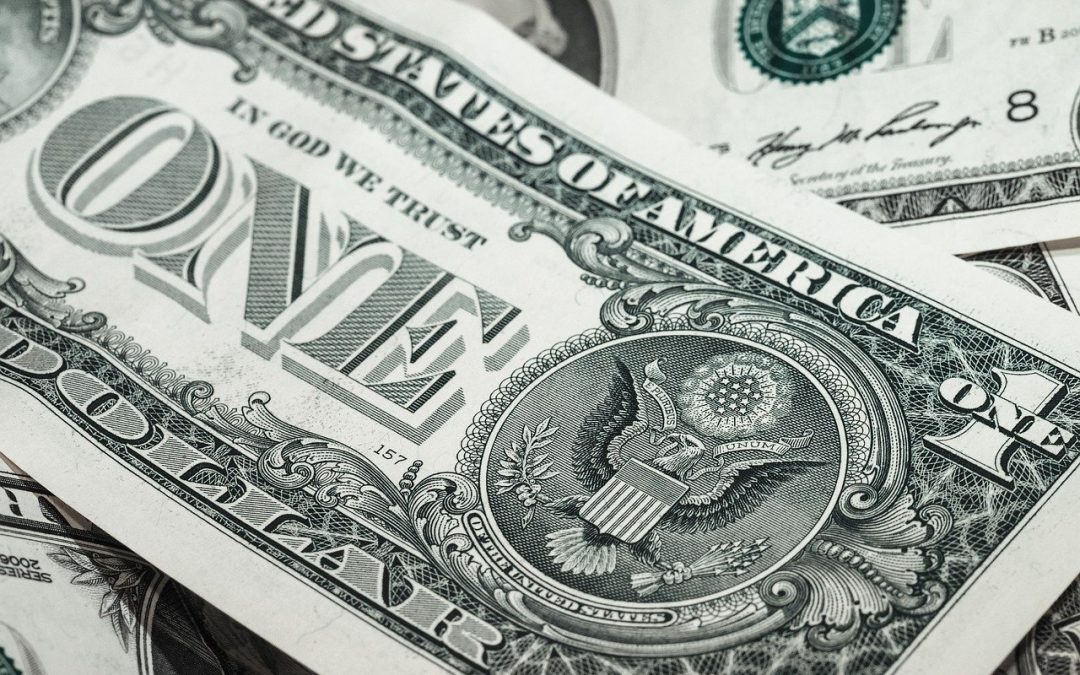
by Sarah Bauder | Jan 8, 2020 | Inflation
By definition, inflation is the general increase in the price of goods and services, and the decrease in the purchasing value of a nation’s currency. Inflation is measured in the consumer price index (or simply CPI), which in turn, calculates the value of a basket of consumer and services purchased by the average household. In this article, 5 experts discuss things you didn’t know about inflation.
I Think A Lot Of People Don’t Really Think About Inflation And Their Money Losing Buying Power
“I think there’s a lot of people out there who either just don’t know about inflation period, or don’t think about it. We all intuitively know things get more expensive over time. A Subway Foot Long used to be $5, now its $8 or $9, things go up in price but I think a lot of people don’t really think about inflation and their money, losing buying power.
I was recently talking to a family friend who left a job of 20 years. They had something like 18k in their retirement account despite making a very good living and having been there 20 years. On the other hand I had been at a much lower paying job for something like 5 years and had over 25k in my 401k. It turned out this family friend wasn’t investing, they were just letting money sit in their retirement account because they were scared of risk and scared of investing. I was trying to explain to them that while all investments have risk, what he’s doing now is guaranteed to lose him money through inflation and over time a pretty substantial amount of money. He didn’t seem to get it and continues to let his retirement money just sit and lose over time.”
John Frigo, Digital Marketing Lead, My Supplement Store
The Word “Inflation” As Originally Coined Applied Entirely To The Quantity Of Money
“The average American does not know or appreciate that the word ‘inflation’ as originally coined, applied entirely to the quantity of money. That is to say, inflation is merely an increase in the quantity of money and bank notes that are in circulation plus the quantity of bank deposits that are subject to check. As such, current operations by Central Banks around the world that electronically create ‘money’ or ‘reserves’ through open market operations and programs such as ‘quantitative easing’ are themselves sufficient to satisfy the original definition of ‘inflation’, even if there is no measurable increase on the price on consumer goods.”
David Reischer, Esq. Banking & Business Attorney, LegalAdvice.com
The Average American Has A Hard Time Even Describing What Inflation Is
“The average American attending my workshops on the basics of personal and household finances knows that inflation is something that can hurt their wallet, but they have a hard time even describing what inflation is.
Many people accept that inflation results in higher prices for goods and services, but they do not understand it as an annual change. Rather, they think of it like they would a sales tax, like something added onto the normal price of goods and services.
The average American knows that prices for gasoline, food and cars were much lower when they were younger, but there is a disconnect between the change in prices and the principle of inflation.
The simplest description of inflation I see my adult students understanding is this: You know how prices seem to go up year after year? That is inflation.
Most adults in my classes typically guess that inflation is far higher than it is, believing it is close to 10% a year rather than the 2.5% to 3.5% rate is has been for the past couple decades. However, even at 3.5%, they do not understand that prices will actually DOUBLE in just twenty years. The Rule of 72 is a powerful tool for teaching about the impact of inflation over time.”
Todd Christensen, Education Manager, Money Fit by DRS
The Correlation Between Interest Rates And Monetary Inflation
“Very few people understand the correlation between interest rates and monetary inflation. When interest rates are suppressed below the GDP rate, which is a reflection of economic output, then interest rates anywhere in the interest curve below this rate results in people being paid to borrow. This is because the rate of interest is below the rate of monetary inflation and thus people are encouraged to expand in ways that are not necessarily economic. To that end, assets that are tied to the interest rate complex largely rise in price as interest rates are lowered.
While the apparent gains in value for assets tied to interest rates like real estate, bonds, commodities, collectibles, may seem engendered by real market demand, in most cases the demand is artificially being created by inflation tied to below market price interest rates. Central Bank meddling in the pricing mechanism for interest rates, which some would say is the most important price in a free market, distorts all markets and that’s why many assets are highly susceptible to the boom-bust cycle of bubbles.”
Brian Ma, Broker, Flushing Real Estate Group
Investing In Real Estate Is The Best Hedge Against Inflation
“One of the most important things which the average American does not know about inflation is that investing in real estate is the best hedge against it. While people are generally aware of the many benefits of real estate investments such as relatively low risk and monthly rental income, they often fail to appreciate the fact that investing in real estate properties protects one’s money against inflation. While housing markets take temporary downturns as a result of economic and demographic factors, they always bounce back. Regardless of which market you look at, real estate prices follow an upward trend in the medium and long term. This is due to the constant increase in housing demand (due to population growth) and the fact that the land on which properties are built is a very limited resource. If we look at data from the past few decades, the average annual appreciation rate in the US exceeds the average annual inflation rate. In 2020 inflation in the US is forecast to reach about 2%, while the increase in the median home value is expected to reach about 2.2%. This means that once again the real estate appreciation rate will exceed the inflation rate, offering investors protection of their financial resources.”
Daniela Andreevska, Marketing Director, Mashvisor
Unfortunately, inflation is an economic reality that is unavoidable. You can keep abreast of the monthly inflation rates and the CPI via the Bureau of Labor Statistics release schedule. The best strategy to hedge against inflation is to ensure that one has a diversified portfolio.
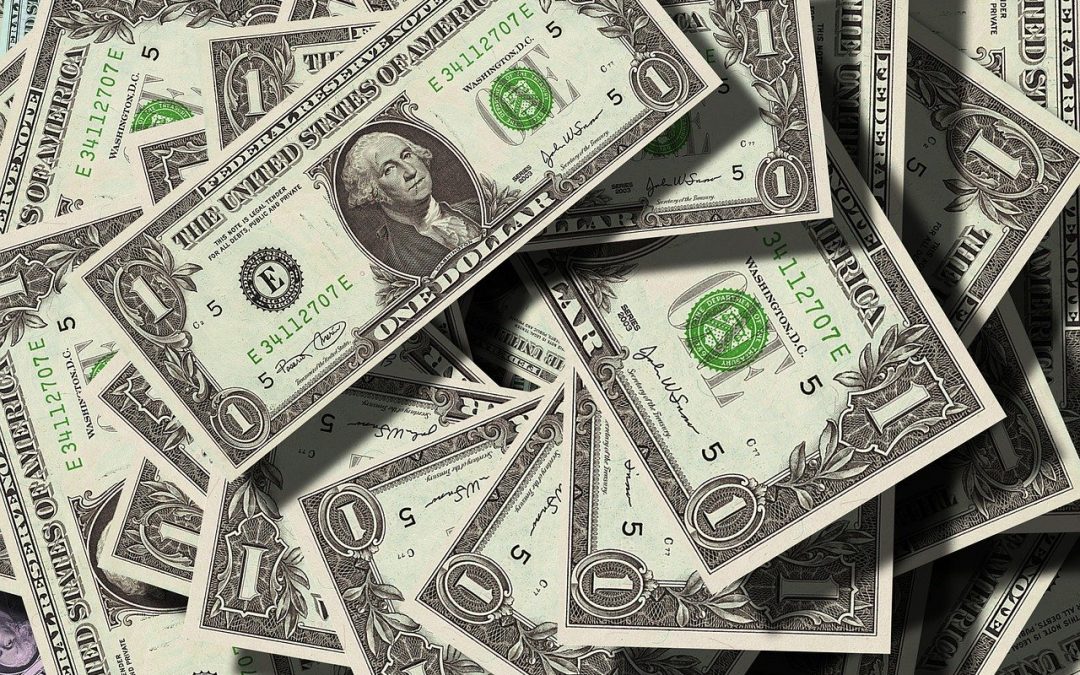
by Sarah Bauder | Dec 3, 2019 | Inflation
Inflation is a general increase in the price of goods and services, and a decline in the value of a nation’s currency. Conversely, deflation is a decrease in the price of goods and services, when the rate of inflation falls below 0%. Additionally, the purchasing power of a nation’s currency will increase during deflation. Inflation is measured by the consumer price index (CPI). The CPI measures the changes in the value of a basket of consumer goods and services purchased by households. In this article, financial experts share their views on whether or not investors should be worried about inflation and deflation.
This Inflation Or Deflation Debate Mixes A Lot Of People Up Because The Same Causal Forces Can Potentially Lead To Both Scenarios
“This inflation or deflation debate mixes a lot of people up because the same causal forces (such as high debt levels) can potentially lead to both scenarios depending on the policy response.
When analyzed in isolation, the current macro environment is deflationary. Debt levels as a percentage of GDP are beyond the point of sustainability, and aging demographics lead to slower economic growth and a larger financial burden on younger generations, leading to high default risk over the next decade. Debt defaults involve the destruction of both liabilities and assets; other peoples’ money, which makes this an extremely deflationary prospect.
However, there is virtually no way that the global financial system, as currently structured, would allow a deflationary debt default to occur in countries that control their own currencies. Historically, the policy response to economic environments with this high of a debt load is for governments and central banks to print their way out of it. In a purely fiat system, there’s nothing stopping financial authorities from increasing the money supply to pay all obligations in nominal terms, even if it causes inflation and fails to pay back those obligations in true purchasing power terms.
Therefore, a deflationary or dis-inflationary environment is possible in the intermediate-term, but an inflationary outcome is almost inevitable over the long term due to the policy response to those deflationary or dis-inflationary forces. Rarely in history do fiat monetary systems allow themselves to default nominally.”
Lyn Alden, founder of Lyn Alden Investment Strategy
Looking Forward Over The Next 12 Months We Do Expect A Dip In The Markets And Some Inflation
“In an inflationary environment the value of money decreases, which spurs consumption and investment. Deflation makes it profitable to simply sit on one’s savings while the value of those savings increases without any special effort, disincentivizing consumption and investing.
Looking forward over the next 12 months we do expect a dip in the markets and some inflation. Therefore we are therefore poised and ready for investment opportunities that may crop up over this period.”
Robin Lee Allen, Managing Partner, Esperance Private Equity
The Commonly-Cited CPI Metric Might Not Be The Best For Practical Purposes
“Sensing you will likely receive numerous responses to your prompt declaring whether investors should worry about potential inflation or deflation, I thought I would offer up a viewpoint about why the commonly-cited CPI metric might not be the best for practical purposes.
The Consumer Price Index (CPI) has long served as the foundational inflation measure for economic activity. In fact, it underpins the health of an economy because a stable CPI measure indicates opportunity for economic prosperity. Absent predictable CPI readings, consumers will not have an accurate signal about price expectations and may change their behavior in detriment to the economy as a whole.
One major limitation to the current CPI measure is its inability to incorporate decisions consumers might actually make when evaluating a fixed basket of goods. For example, when a price increases for one consumer product included in the selection of goods used to measure CPI, many consumers would choose to switch to a substitute. CPI doesn’t account for this reality. Instead, CPI assumes the consumer would simply pay more for the same product. Reality usually shows a different response in the form of choosing a substitute product.
Instead, a better measure, which accounts for this substitution effect would be “chained CPI.” This more closely resembles the substitution decisions consumers would make in response to rising prices of certain items as opposed to simply paying more for the same good. This metric will capture the switching dynamic.”
Riley Adams, CPA
A Cost-Averaging Strategy Into A Healthy, Low-Cost, Diversified Stock Portfolio
“For anyone investing in their future over the long term, they know that everything moves through cycles. There are booms, and there are recessions. Sometimes the latter morph into depressions. And inside these, there are deflationary and inflationary times. Piecing it all together, unless you are an econometric expert, is almost impossible.
The problem is that events in the economy can move fast between inflationary and deflationary forces. Reaction time can be a severe challenge. For the everyday, hard-working American who puts some earnings aside at the end of every month and religiously injects it into a portfolio, keep it up. By cost averaging over time, you automatically smooth out the many ragged edges and the volatility shocks. Then, my recommendation is to invest it in the S&P 500 (a low-cost fund) that evenly spreads every invested dollar over the public markets’ best stocks. By so doing, you are trusting growth stocks and companies immersed in unearthing and refining commodities like gold and platinum (inflationary hedges). Also, defensive stocks like businesses in consumer goods, and well-known dividend-paying stocks (deflationary hedges). You may want to put a small percentage outside the S&P 500 fund into Treasury Inflation-protected treasuries, investment bonds, and keep some cash on hand (both deflationary protectors).
In short, I recommend a cost-averaging strategy into a healthy, low-cost, diversified stock portfolio as the spearhead of a balanced approach to counteract market ups and downs, rollicked by inflation and deflation from within.”
Gordon Polovin, finance expert, serves on the advisory board for Wealthy Living Today
It’s Definitely Something That People Should Be Concerned About
“Central Banks around the world have a target to keep inflation at roughly around 2% (depending on the country this can be higher or lower). Anything more or less than that can be harmful to the economy. If the inflation is too high, prices of goods and services will rise sharply, and the value of cash or bonds will fall. This has happened numerous times in countries like Germany (after the war), Argentina, Zimbabwe etc. Things can get so bad sometimes that prices double every few hours! This is called hyperinflation and Zimbabwe eventually ended up abolishing its currency and instead using foreign currencies as legal tender! Inflation that is too low or negative (deflation) is equally dangerous. It essentially means that good and services will be cheaper tomorrow than they are today. This incentivizes hoarding of cash. With less demand, economic growth slows down and businesses begin to suffer. Inflation levels also impact export competitiveness compared to other countries, foreign investments and can also impact the value of personal or national debts. It’s definitely something that people should be concerned about which is why Central Banks have set targets in the first place.”
Gaurav Sharma, Founder at BankersByDay
Deflation Can Mean A Drop In Wages Or A Drop In Market Prices
“Deflation can mean a drop in wages or a drop in market prices. Not everyone experiences these drops equally and those who are already secure in a higher paycheck won’t notice either of these factors. However, those who are at the bottom of the business have something to worry about. They are likely to experience a cut in hours or a cut in pay, meaning that while they might notice a drop in market prices, they won’t have the additional income to appreciate it. It’s also important to consider that people are constantly looking for a better deal. In the hopes of finding this deal, people will often stop buying and wait. This can cause a dip in sales and cause trouble with the economy.
Inflation doesn’t necessarily make people secure, however. Inflation means a bump in prices, meaning that the dollar in your pocket is worth less than it was before inflation. Now your paycheck doesn’t go as far and you’re concerned about that. You’ll have less for superfluous spending. You’ll hold onto what little wealth you have and as a result the economy will start to dip.”
Chane Steiner, CEO, Crediful.com
The Outlook Right Now Looks Like One Of Slower Inflation And Because Of That The Risk Of Deflation Is More Of A Concern Now
“Currently the outlook right now looks like one of slower inflation and because of that the risk of deflation is more of a concern now than that of inflation. There are a number of reasons for slower inflation including an aging demographic, technology advancement, inflation expectations, and a stronger dollar. Studies have shown that the aging of demographics has a negative correlation for inflation. In other words, that as a population ages, inflation starts to fall. A good example of this would be Japan, which has battle very low inflation for around the last 25 years. Technology advancement has brought down the price of goods that use new technologies intensively. Historically there has been a correlation of higher productivity with lower inflation. Productivity has been lower recently ,so unless this changes this could be a reason why we start to see inflation rise.
Next, inflation expectations is an important factor in inflation. The higher people think prices are going to go, the more workers will want higher wages, and the higher businesses will believe their costs, and the prices they can charge, will rise. The opposite is true as well, as we are currently seeing inflation expectations from that of the University of Michigan as well as the break-even inflation rate set in Treasury inflation-protected securities. Finally, the stronger dollar leads to lower inflation. This happens because a strong dollar makes foreign imports cheaper which in turn result is cheaper products at U.S. stores, and those lower prices translate to low inflation. So, in order to see the inflation outlook change, we would need to see changes in these factors in order to make that happen.”
Scott Pederson, Financial Advisor, Harmony Wealth Managment LLC
Investor Should Be Worried About Inflation And Deflation
“Yes, the investor should be worried about inflation and deflation. These both are the major economic factors, and investors should keep them in mind before investing money.
Inflation means the increase in the price of products and a decrease in the value of money value. Regarding this basic rule, investors should invest in products whose return or profit margin would be higher than the inflation rate. For example: If the investor is investing $100 and is expected to get $2 profit next year. He must see what would be the inflation rate. If it would be 3%, then the investor is at a loss of $1.
In times of deflation, investors should preserve the capital or invest in the good having the high return potential in the future. Investment in gold is recommended because no matter what, even after a minimal decrease, its prices go high. So, the rule of thumb is either to preserve the capital or invest it in the products with the potential of higher ROI. Business bankruptcy rates increase during this period. So, do not keep your stock shares or corporate bonds in the companies having the risk of bankruptcy. Instead, invest them in potential business or goods to remain on the safe side. “
CJ Xia, VP of Marketing & Sales at Boster Biological Technology
Both Have Negative Consequences
“Generally, as the economy recovers, banks are able to loan out their excess reserves to the public. With the increase in money supply, inflationary pressure is also built, causing the prices of goods and services to rise. This worries ordinary citizens, especially those who live pay check-to-pay check because the affordability of basic goods and services is more difficult.
On the other hand, deflation impacts consumers by way of raising their purchasing power since goods and services have become more affordable. But while this may be good news to the public, the same thing cannot be said for enterprises who are affected by the low prices of their goods and services. Eventually when deflation persists, they will be forced to cut jobs and shut down. The public then experiences decline in incomes and therefore, consumer confidence plunges.”
Doug Keller, Writer, Finance Fox
Both inflation and deflation are economic components that unfortunately cannot be avoided. Keep up with monthly inflation rates and the CPI via the Bureau of Labor Statistics release schedule. In order to offset the market ups and downs during periods of inflation and deflation, a diversification strategy for one’s portfolio is the best bet.














